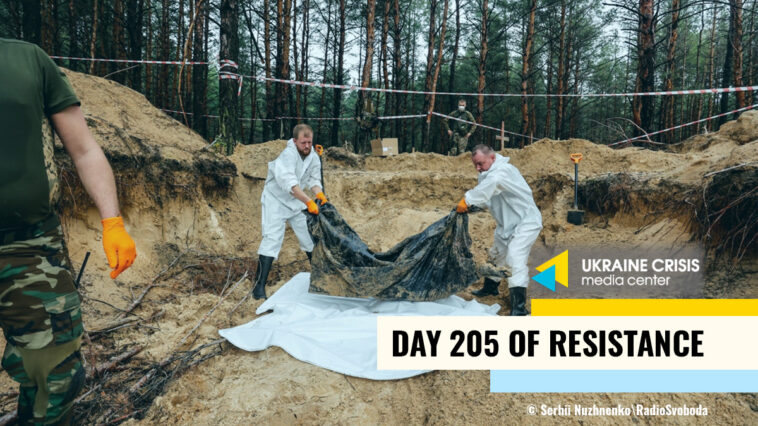Number of victims in Izyum may exceed that of Bucha, government commissioner says
The number of victims in Izyum, in Kharkiv region may exceed that of Bucha, the Ukrainian Government’s Commissioner on missing persons under special circumstances Oleh Kotenko said.
In Izyum, [Ukrainian investigators and prosecutors] began to exhume bodies from a mass burial site, the Ministry for Reintegration of Temporarily Occupied Territories of Ukraine said. One of the sites was discovered through a video posted to social media by the Russians, Kotenko added.
Over the past week, in recaptured areas of Kharkiv region, about 50 bodies of civilians were recovered (outside the mass burial site), head of the National Police Ihor Klymenko said in a news conference.
“There are nearly 445 graves at the mass burial site [on the outskirts of Izyum]. We’ll work to figure out injury types and causes of death. It will take weeks to do that. (…) The bodies have been buried since March. We’ll exhume and identify each body,” Klymenko added.
Russia-installed officials killed in Berdyansk, Luhansk. Administration building struck in Kherson
On Friday, September 16, there was a number of attacks against the representatives of the Russia-installed administrations in the occupied areas of Ukraine.
In occupied Luhansk, the office of the so-called “prosecutor general” of “LNR” Sergey Gorenko was blown up. He died in hospital from injuries he sustained. His deputy was also killed in the attack.
“Elimination of so-called ‘LNR prosecutor general’ and his deputy should be considered as showdowns of local organized criminal groups that could not share looted property before a large-scale escape. Or as Russian Federation’s purge of witnesses to war crimes. Investigation will show,” advisor to the head of the Office of the President of Ukraine Mykhailo Podolyak twitted.
In Russia-occupied Berdyank, in Zaporizhzhia region, Oleh Boyko, Russia-installed deputy head of the occupation administration of the town, and his wife, Lyudmyla, who headed preparations to a fake referendum on the Zaporizhzhia region joining Russia, were killed on Friday.
A massive explosion rocked the center of occupied Kherson. The strike possibly targeted the regional administration building seized by Russia. Other reports say the target was the court of appeal.
The General Staff of the Ukrainian Armed Forces issued no statements on the issue.
Photo by Azov service member wins prize at International Photography Awards
A photo by Ukrainian photographer and service member Dmytro “Orest” Kozatskyi who defended Azovstal, won a prize at the International Photography Awards.
His photo entitled “Light will win” #SaveAzovstal” was announced the first place winner in the section “Editorial/ Press/ War / Conflict”.
Other winning photos in the category’s eight subsections cover hostilities in Kabul, the U.S. Capitol attack, sports etc.
Dmytro Kozatskyi is held prisoner by Russia, like hundreds of other Mariupol defenders. His works continue to win awards internationally and shed light on Russia’s war in Ukraine.
International Photography Awards is a prestigious competition with prizes reaching USD 200,000.
Dmytro’s photo taken at Azovstal recently won an award at the “Prix de la Photographie” competition in Paris. He won Gold in the Press/War category, and is the second place winner in the Press section.
Before surrendering to the Russians, Dmytro Kozatskyi granted open access to his photos and called to submit them to competitions. “I leave you my photos in the best quality. While I am in captivity, do submit them to journalism and photo competitions. I will be glad to discover I had won awards after I am released. Thank you all for support. See you,” Dmytro Kozatskyi twitted on May 20.
Volunteers who help people with disabilities amid war. Ukraine in Flames #190
Until February 24, Dmytro Maksymovych was engaged in marketing and lived in Kyiv. When the war started, he moved with his wife to Chernivtsi, while his mother stayed in Kyiv. As soon as staying in Kyiv became dangerous, the mother agreed to move away from there. Then Dmytro was forced to turn to volunteers for help. Soon he himself became part of a volunteer community that evacuates people from hot spots of war. Even later, they were among the first in Ukraine to choose a niche for themselves – to evacuate those who no one wants to deal with: people with disabilities.
Speakers:
- Dmytro Maksymovych, volunteer
- Natalia Kantsidal, social worker of “Caritas” Foundation

